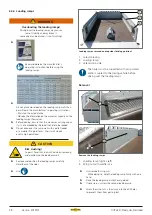
OI (Part 2): Steely, HA, Startrailer
Version 2019/01
13
6
Loading and Unloading
Single-axle trailers may only be loaded and
unloaded with goods after being coupled to the
towing vehicle.
6.1 Load distribution
CAUTION
Negative / insufficient drawbar load!
Maximum permissible drawbar load exceeded!
A negative / too-low drawbar load or exceeding the maximum
permissible drawbar load may result in accidents.
►
►
Distribute the weight evenly across the trailer.
►
►
Do not fall below the minimum drawbar load of the
trailer (for trailers up to 750 kg gross weight, this is:
4% of the towed load or 25 kg).
►
►
Do not exceed the maximum permissible drawbar load
of the towing vehicle and trailer coupling.
►
►
Where possible, make use of the maximum permissible
drawbar load (see COC papers, Section 19).
►
►
Observe the information on the maximum
permissible drawbar load in your vehicle papers
and the trailer coupling.
►
►
Do not exceed the maximum permissible drawbar load
of the trailer. Observe the information on the maximum
permissible drawbar load in the COC papers, Section 19.
Avoid turning your load into a projectile.
•
The static force [m] is used as a point of departure
for dimensioning the means of load securing.
•
As the speed increases, so does the inertia /
centrifugal force of the load.
•
Sample calculation:
[m] = 1 kg ~ 1 daN static force
[v] = acceleration speed of mass
[E
kin
] Formula: E
kin
= m
•
v
2
2
at 0 kph = 1 kg kinetic energy
at 40 kph =
~
600 kg kinetic energy
at 80 kph =
~
2,400 kg kinetic energy
100 kg
0 km/h
Vehicle standing still
~ 6000 kg
40 km/h
Fully braked at 40 kph
~ 24000 kg
80 km/h
Forces acting on trailer when fully braked
Conclusion:
•
When doubling the speed, the kinetic energy that
can be released by the unsecured load when the
trailer is fully braked increases four-fold.
•
Wrongly / poorly distributing the load results in
serious accidents, even at low speeds.
•
Overloading the trailer means intentionally producing a
risk, which can result in the trailer skidding and meeting
with a serious accident even after a minor steering
manoeuvre, a bump in the road or a gust of wind!
0.5
0.5
0.5
0.8
kg
Forces to be secured against skidding
•
Securing at the front
(when fully braked)
0.8 or 80% of the static force:
e.g. 500 kg must be secured with 400 daN
•
Securing at the side / rear
(when swerving / starting / driving round bends)
0.5 or 50% of the static force:
e.g. 500 kg must be secured with 250 daN














































